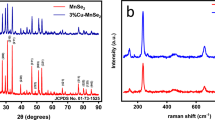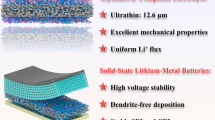Abstract
Owing to the high theoretical capacity, metal sulfides have emerged as promising anode materials for potassium-ion batteries (PIBs). However, sluggish kinetics, drastic volume expansion, and polysulfide dissolution during charge/discharge result in unsatisfactory electrochemical performance. Herein, we design a core-shell structure consisting of an active bismuth sulfide core and a highly conductive sulfur-doped carbon shell (Bi2S3@SC) as a novel anode material for PIBs. Benefiting from its unique core-shell structure, this Bi2S3@SC is endowed with outstanding potassium storage performance with high specific capacity (626 mAh·g−1 under 50 mA·g−1) and excellent rate capability (268.9 mAh·g−1 at 1 A·g−1). More importantly, a Bi2S3@SC//KFe[Fe(CN)6] full cell is successfully fabricated, which achieves a high reversible capacity of 257 mAh·g−1 at 50 mA·g−1 over 50 cycles, holding great potentials in practical applications. Density functional theory (DFT) calculations reveal that potassium ions have a low diffusion barrier of 0.54 eV in Bi2S3 due to the weak van der Waals interactions between layers. This work heralds a promising strategy in the structural design of high-performance anode materials for PIBs.

Similar content being viewed by others
References
Larcher, D.; Tarascon, J. M. Towards greener and more sustainable batteries for electrical energy storage. Nat. Chem. 2015, 7, 19–29.
Gür, T. M. Review of electrical energy storage technologies, materials and systems: Challenges and prospects for large-scale grid storage. Energy Environ. Sci. 2018, 11, 2696–2767.
Yang, C. Y.; Chen, J.; Ji, X.; Pollard, T. P.; Lü, X. J.; Sun, C. J.; Hou, S.; Liu, Q.; Liu, C. M.; Qing, T. T. et al. Aqueous Li-ion battery enabled by halogen conversion-intercalation chemistry in graphite. Nature 2019, 569, 245–250.
Jin, H. C.; Xin, S.; Chuang, C. H.; Li, W. D.; Wang, H. Y.; Zhu, J.; Xie, H. Y.; Zhang, T. M.; Wan, Y. Y.; Qi, Z. K. et al. Black phosphorus composites with engineered interfaces for high-rate high-capacity lithium storage. Science 2020, 370, 192–197.
Luo, W.; Li, F.; Zhang, W. R.; Han, K.; Gaumet, J. J.; Schaefer, H. E.; Mai, L. Q. Encapsulating segment-like antimony nanorod in hollow carbon tube as long-lifespan, high-rate anodes for rechargeable K-ion batteries. Nano Res. 2019, 12, 1025–1031.
Yabuuchi, N.; Kubota, K.; Dahbi, M.; Komaba, S. Research development on sodium-ion batteries. Chem. Rev. 2014, 114, 11636–11682.
Zhu, Y. H.; Yuan, S.; Bao, D.; Yin, Y. B.; Zhong, H. X.; Zhang, X. B.; Yan, J. M.; Jiang, Q. Decorating waste cloth via industrial wastewater for tube-type flexible and wearable sodium-ion batteries. Adv. Mater. 2017, 29, 1603719.
Aurbach, D.; Lu, Z.; Schechter, A.; Gofer, Y.; Gizbar, H.; Turgeman, R.; Cohen, Y.; Moshkovich, M.; Levi, E. Prototype systems for rechargeable magnesium batteries. Nature 2000, 407, 724–727.
Lin, M. C.; Gong, M.; Lu, B. G.; Wu, Y. P.; Wang, D. Y.; Guan, M. Y.; Angell, M.; Chen, C. X.; Yang, J.; Hwang, B. J. et al. An ultrafast rechargeable aluminium-ion battery. Nature 2015, 520, 324–328.
Hosaka, T.; Kubota, K.; Hameed, A. S.; Komaba, S. Research development on K-ion batteries. Chem. Rev. 2020, 120, 6358–6466.
Zhu, Y. H.; Yin, Y. B.; Yang, X.; Sun, T.; Wang, S.; Jiang, Y. S.; Yan, J. M.; Zhang, X. B. Transformation of rusty stainless-steel meshes into stable, low-cost, and binder-free cathodes for high-performance potassium-ion batteries. Angew. Chem., Int. Ed. 2017, 56, 7881–7885.
Zhang, W. C.; Liu, Y. J.; Guo, Z. P. Approaching high-performance potassium-ion batteries via advanced design strategies and engineering. Sci. Adv. 2019, 5, eaav7412.
Lei, K. X.; Wang, C. C.; Liu, L. J.; Luo, Y. W.; Mu, C. N.; Li, F. J.; Chen, J. A porous network of bismuth used as the anode material for high-energy-density potassium-ion batteries. Angew. Chem., Int. Ed. 2018, 57, 4687–4691.
Li, Y.; Jiang, S.; Qian, Y.; Yan, X. D.; Zhou, J.; Yi, Z.; Lin, N.; Qian, Y. T. 2D interspace confined growth of ultrathin MoS2-intercalated graphite hetero-layers for high-rate Li/K storage. Nano Res. 2021, 14, 1061–1068.
Tong, H. G.; Wang, C. L.; Lu, J.; Chen, S.; Yang, K.; Huang, M. X.; Yuan, Q.; Chen, Q. W. Energetic metal-organic frameworks derived highly nitrogen-doped porous carbon for superior potassium storage. Small 2020, 16, 2002771.
Bin, D. S.; Lin, X. J.; Sun, Y. G.; Xu, Y. S.; Zhang, K.; Cao, A. M.; Wan, L. J. Engineering hollow carbon architecture for high-performance K-ion battery anode. J. Am. Chem. Soc. 2018, 140, 7127–7134.
Wu, X. Y.; Leonard, D. P.; Ji, X. L. Emerging non-aqueous potassium-ion batteries: Challenges and opportunities. Chem. Mater. 2017, 29, 5031–5042.
Ji, B. F.; Yao, W. J.; Zheng, Y. P.; Kidkhunthod, P.; Zhou, X. L.; Tunmee, S.; Sattayaporn, S.; Cheng, H. M.; He, H. Y.; Tang, Y. B. A fluoroxalate cathode material for potassium-ion batteries with ultra-long cyclability. Nat. Commun. 2020, 11, 1225.
Zhu, Y. H.; Zhang, Q.; Yang, X.; Zhao, E. Y.; Sun, T.; Zhang, X. B.; Wang, S.; Yu, X. Q.; Yan, J. M.; Jiang, Q. Reconstructed orthorhombic V2O5 polyhedra for fast ion diffusion in K-ion batteries. Chem 2019, 5, 168–179.
Xiong, P.; Zhang, F.; Zhang, X. Y.; Wang, S. J.; Liu, H.; Sun, B.; Zhang, J. Q.; Sun, Y.; Ma, R. Z.; Bando, Y. et al. Strain engineering of two-dimensional multilayered heterostructures for beyond-lithium-based rechargeable batteries. Nat. Commun. 2020, 11, 3297.
Liu, Y. J.; Tai, Z. X.; Zhang, J.; Pang, W. K.; Zhang, Q.; Feng, H. F.; Konstantinov, K.; Guo, Z. P.; Liu, H. K. Boosting potassium-ion batteries by few-layered composite anodes prepared via solution-triggered one-step shear exfoliation. Nat. Commun. 2018, 9, 3645.
Peng, Q. K.; Zhang, S. P.; Yang, H.; Sheng, B. B.; Xu, R.; Wang, Q. S.; Yu, Y. Boosting potassium storage performance of the Cu2S anode via morphology engineering and electrolyte chemistry. ACS Nano 2020, 14, 6024–6033.
Liu, Y.; Sun, Z. H.; Sun, X.; Lin, Y.; Tan, K.; Sun, J. F.; Liang, L. W.; Hou, L. R.; Yuan, C. Z. Construction of hierarchical nanotubes assembled from ultrathin V3S4@C nanosheets towards alkali-ion batteries with ion-dependent electrochemical mechanisms. Angew. Chem., Int. Ed. 2020, 59, 2473–2482.
Huang, Y. Z.; Hu, X.; Li, J. W.; Zhang, J. S.; Cai, D. P.; Sa, B. S.; Zhan, H. B.; Wen, Z. H. Rational construction of heterostructured core-shell Bi2S3@Co9S8 complex hollow particles toward highperformance Li- and Na-ion storage. Energy Storage Mater. 2020, 29, 121–130.
Xiong, T.; Wang, Y. M.; Yin, B. S.; Shi, W.; Lee, W. S. V.; Xue, J. M. Bi2S3 for aqueous Zn ion battery with enhanced cycle stability. Nano-Micro Lett. 2020, 12, 8.
Zhao, Y. B.; Manthiram, A. Bi0.94Sb1.06S3 nanorod cluster anodes for sodium-ion batteries: Enhanced reversibility by the synergistic effect of the Bi2S3-Sb2S3 solid solution. Chem. Mater. 2015, 27, 6139–6145.
Ni, J. F.; Bi, X. X.; Jiang, Y.; Li, L.; Lu, J. Bismuth chalcogenide compounds Bi2X3 (X = O, S, Se): Applications in electrochemical energy storage. Nano Energy 2017, 34, 356–366.
Sun, W. P.; Rui, X. H.; Zhang, D.; Jiang, Y. Z.; Sun, Z. Q.; Liu, H. K.; Dou, S. X. Bismuth sulfide: A high-capacity anode for sodium-ion batteries. J. Power Sources 2016, 309, 135–140.
Jin, R. C.; Li, G. H.; Liu, J. S.; Yang, L. X. A facile route to flowerlike Bi2S3 constructed by polycrystalline nanoplates with enhanced electrochemical properties. Eur. J. Inorg. Chem. 2013, 2013, 5400–5407.
Fang, Y. J.; Luan, D. Y.; Lou, X. W. Recent advances on mixed metal sulfides for advanced sodium-ion batteries. Adv. Mater. 2020, 32, 2002976.
Yong, B.; Ma, D. T.; Wang, Y. Y.; Mi, H. W.; He, C. X.; Zhang, P. X. Understanding the design principles of advanced aqueous zinc-ion battery cathodes: From transport kinetics to structural engineering, and future perspectives. Adv. Energy Mater. 2020, 10, 2002354.
Huang, H.; Wang, J.; Yang, X.; Hu, R.; Liu, J.; Zhang, L.; Zhu, M. Unveiling the advances of nanostructure design for alloy-type potassium-ion battery anodes via in situ TEM. Angew. Chem., Int. Ed. 2020, 59, 14504–14510.
Wang, J.; Fan, L.; Liu, Z. M.; Chen, S. H.; Zhang, Q. F.; Wang, L. L.; Yang, H. G.; Yu, X. Z.; Lu, B. G. In situ alloying strategy for exceptional potassium ion batteries. ACS Nano 2019, 13, 3703–3713.
Liang, H. C.; Ni, J. F.; Li, L. Bio-inspired engineering of Bi2S3-PPy yolk-shell composite for highly durable lithium and sodium storage. Nano Energy 2017, 33, 213–220.
Chang, X. Q.; Zhou, X. L.; Ou, X. W.; Lee, C. S.; Zhou, J. W.; Tang, Y. B. Ultrahigh nitrogen doping of carbon nanosheets for high capacity and long cycling potassium ion storage. Adv. Energy Mater. 2019, 9, 1902672.
Ni, J. F.; Zhao, Y.; Liu, T. T.; Zheng, H. H.; Gao, L. J.; Yan, C. L.; Li, L. Strongly coupled Bi2S3@CNT hybrids for robust lithium storage. Adv. Energy Mater. 2014, 4, 1400798.
Gonbeau, D.; Bouih, H.; Pfister-Guillouzo, G.; Menetrier, M.; Levasseur, A. X-ray photoelectron spectrum of glassy B2S3. Experimental and theoretical study. J. Chem. Soc., Faraday Trans. 1995, 91, 93–97.
Liu, B. L.; Liu, Z. J.; Li, D.; Guo, P. Q.; Liu, D.; Shang, X. N.; Lv, M. Z.; He, D. Y. Nanoscale α-MnS crystallites grown on N-S co-doped rGO as a long-life and high-capacity anode material of Li-ion batteries. Appl. Surf. Sci. 2017, 416, 858–867.
Vogt, A. D.; Han, T.; Beebe, T. P. Adsorption of 11-mercaptoundecanoic acid on Ni(111) and its interaction with probe molecules. Langmuir 1997, 13, 3397–3403.
Farrell, S. P.; Fleet, M. E.; Stekhin, I. E.; Kravtsova, A.; Soldatov, A. V.; Liu, X. Y. Evolution of local electronic structure in alabandite and niningerite solid solutions [(Mn,Fe)S, (Mg,Mn)S, (Mg,Fe)S] using sulfur K- and L-edge XANES spectroscopy. Am. Mineral. 2002, 87, 1321–1332.
Brezesinski, T.; Wang, J.; Tolbert, S. H.; Dunn, B. Ordered mesoporous α-MoO3 with iso-oriented nanocrystalline walls for thin-film pseudocapacitors. Nat. Mater. 2010, 9, 146–151.
Jian, Z. L.; Luo, W.; Ji, X. L. Carbon electrodes for K-ion batteries. J. Am. Chem. Soc. 2015, 137, 11566–11569.
Manna, G.; Bose, R.; Pradhan, N. Photocatalytic Au-Bi2S3 heteronanostructures. Angew. Chem., Int. Ed. 2014, 53, 6743–6746.
Acknowledgements
This study was supported by the Hong Kong Scholars Program (No. XJ2019022), the Fundamental Research Funds for the Central Universities (No. WK2060000032), the National Natural Science Foundation (Nos. 51772283, 21972145, and 51872249), and General Research Fund (GRF, No. CityU 11307619). The DFT calculations were completed on the supercomputing system in the Supercomputing Center of the University of Science and Technology of China. We thank the Beamlines MCD-A and MCD-B (Soochow Beamline for Energy materials) at the National Synchrotron Radiation Laboratory (NSRL) in the University of Science and Technology of China for measuring XANES of sulfur L-edge.
Author information
Authors and Affiliations
Corresponding authors
Electronic Supplementary Material
12274_2021_3560_MOESM1_ESM.pdf
Structural engineering of sulfur-doped carbon encapsulated bismuth sulfide core-shell structure for enhanced potassium storage performance
Rights and permissions
About this article
Cite this article
Wang, C., Lu, J., Tong, H. et al. Structural engineering of sulfur-doped carbon encapsulated bismuth sulfide core-shell structure for enhanced potassium storage performance. Nano Res. 14, 3545–3551 (2021). https://doi.org/10.1007/s12274-021-3560-3
Received:
Revised:
Accepted:
Published:
Issue Date:
DOI: https://doi.org/10.1007/s12274-021-3560-3




